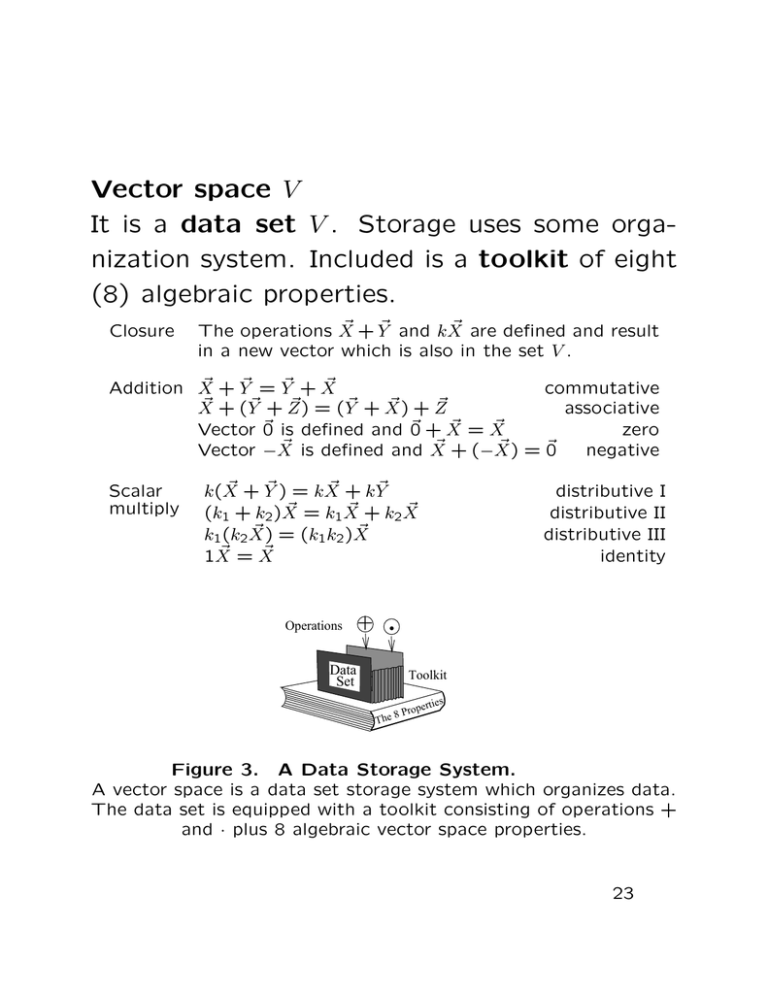Vector space V nization system. Included is a toolkit of eight
advertisement

Vector space V
It is a data set V . Storage uses some organization system. Included is a toolkit of eight
(8) algebraic properties.
Closure
~ +Y
~ and kX
~ are defined and result
The operations X
in a new vector which is also in the set V .
~ +Y
~ =Y
~ +X
~
Addition X
commutative
~
~
~
~
~
~
X + (Y + Z) = (Y + X) + Z
associative
~
~
Vector ~0 is defined and ~
0+X =X
zero
~
~
~
Vector −X is defined and X + (−X) = ~
0
negative
Scalar
multiply
~ +Y
~ ) = kX
~ + kY
~
k(X
~ = k1 X
~ + k2 X
~
(k1 + k2 )X
~ = (k1 k2 )X
~
k1 (k2 X)
~ =X
~
1X
Operations
+
distributive I
distributive II
distributive III
identity
.
Data
Set
Toolkit
8
The
s
ertie
Prop
Figure 3. A Data Storage System.
A vector space is a data set storage system which organizes data.
The data set is equipped with a toolkit consisting of operations +
and · plus 8 algebraic vector space properties.
23
Theorem 5 (Subspaces and Restriction Equations)
Let V be one of the vector spaces Rn and let A be an
m × n matrix. Define a smaller set of data items from
V by the equation
S = {x : x in S,
Ax = 0}.
Then S is a subspace of V , that is, operations of addition
and scalar multiplication applied to data items in S give
answers in S and the 8-property toolkit applies to data
items in S.
Proof: Zero is in V because A0 = 0 for any matrix A. To verify
the subspace criterion, we verify that z = c1 x + c2 y for x and y in
V also belongs to V . The details:
Az = A(c1 x + c2y)
= A(c1 x) + A(c2 y)
= c1 Ax + c2 Ay
= c1 0 + c2 0
Because Ax = Ay = 0, due to x, y
in V .
=0
Therefore, Az = 0, and z is in V .
The proof is complete.
24
Independence test for two vectors v1 , v2.
In an abstract vector space V , form the equation
c1 v1 + c2 v2 = 0.
Solve this equation for c1 , c2 . Then v1 , v2 are
independent in V only if the system has unique
solution c1 = c2 = 0.
Illustration. Two column vectors are tested for independence by
forming the system of equations c1 v1 + c2 v2 = 0, e.g,
c1
−1
1
+ c2
2
1
=
0
0
.
c1
c2
.
This is a homogeneous system Ac = 0 with
A=
−1
1
2
1
,
c=
The system Ac = 0 can be solved for c by rref methods. Because
rref (A) = I, then c1 = c2 = 0, which verifies independence.
If the system Ac = 0 is square, then det(A) 6= 0 applies to test
independence. There is no chance to use determinants when
the system is not square. For instance, in R3 , the homogeneous
system
0
2
−1
0
1
1
=
+ c2
c1
0
0
0
has vector-matrix form Ac = 0 with 3 × 2 matrix A.
25
Rank Test.
In the vector space Rn , the key to detection of independence is zero free variables, or nullity zero, or equivalently, maximal rank.
The test is justified from the
formula nullity(A) + rank(A) = k, where k is the column dimension of A.
Theorem 6 (Rank-Nullity Test)
Let v1, . . . , vk be k column vectors in Rn and
let A be the augmented matrix of these vectors. The vectors are independent if rank(A) =
k and dependent if rank(A) < k. The conditions are equivalent to nullity(A) = 0 and
nullity(A) > 0, respectively.
26
Determinant Test.
In the unusual case when the system arising in the independence test can be expressed as Ac = 0 and A
is square, then det(A) = 0 detects dependence, and
det(A) 6= 0 detects independence.
The reasoning is
based upon the formula A−1 = adj(A)/ det(A), valid exactly when det(A) 6= 0.
Theorem 7 (Determinant Test)
Let v1, . . . , vn be n column vectors in Rn and
let A be the augmented matrix of these vectors. The vectors are independent if det(A) 6=
0 and dependent if det(A) = 0.
27
The following test enumerates three common conditions
for which S fails to pass the sanity test for a subspace.
It is justified from the subspace criterion.
Theorem 8 (Testing S not a Subspace)
Let V be an abstract vector space and assume S is a
subset of V . Then S is not a subspace of V provided
one of the following holds.
(1) The vector 0 is not in S.
(2) Some x and −x are not both in S.
(3) Vector x + y is not in S for some x and y in S.
28


